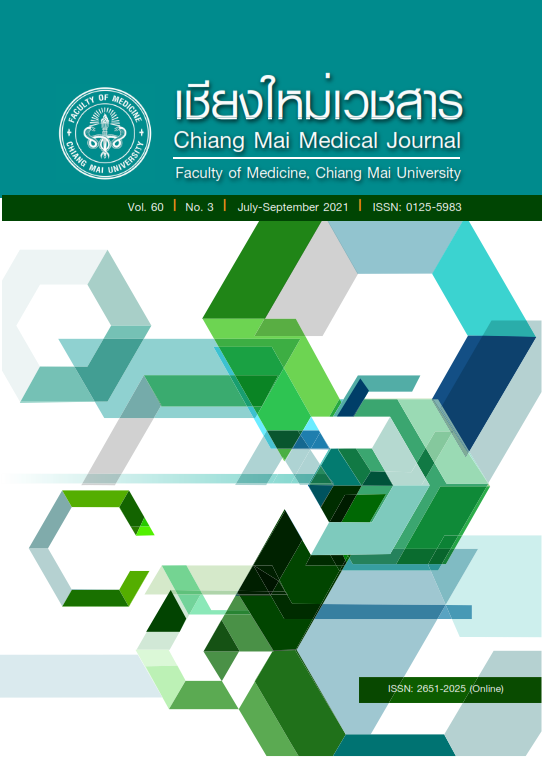Survey of knowledge, perceptions and practices regarding biosafety of medical students in the Faculty of Medicine, Chiang Mai University in Academic Year 2019
Main Article Content
Abstract
Objectives The study was designed to identify differences and correlations among the knowledge, perceptions and practices regarding biosafety of medical students in the Faculty of Medicine, Chiang Mai University.
Methods This cross-sectional descriptive and analytical study was conducted with 321 2nd through 5th year medical students via a self-administered questionnaire survey.
Results In the area of knowledge of biosafety, the 2nd year students had more knowledge regarding disinfection with 70% alcohol and cleaning materials than 3rd and 5th year students (p = 0.023 and p = 0.002, respectively). There was a greater lack of knowledge regarding biohazard signs (p = 0.01 and p = 0.001) and biosafety levels (p < 0.001 and p < 0.001) among clinical students than among 2nd year students. As to perceptions regarding biosafety, clinical students tended to ignore risks of infection from their used ward clothes (p = 0.008 and p = 0.003), lack of hand washing (p < 0.001 and p < 0.001), and cleaning their lab coat or ward coat (p = 0.007 and p = 0.013) more than the 2nd year students. In the area of practice of biosafety, incorrect practices were more common among clinical students than 2nd year students, e.g., cleaning the lab bench after working with human pathogens (p < 0.001 and p < 0.001), bringing food and drinks into the operating area (p < 0.001 and p < 0.001), and improperly disposing of infectious-trash (p = 0.006 and p = 0.007). Spearman’s rank correlation coefficient showed strong correlations among the level of agreement with statements regarding wearing shoes coverings in a biosafety level 2 laboratory (r = 0.404), disposing of contaminated lab gloves, gauze, and cotton (r = 0.479), and decontaminating accidentally spilled chemicals/specimens (r = 0.474), as well as the frequency of cleaning the lab bench after working (r = 0.430), performing microbiology activities without using aseptic techniques (r = 0.524), and wearing laboratory slippers inside a laboratory or ward (r = 0.442) with the average perception and practice scores of the 2nd to 5th year students.
Conclusions Clinical students tended to ignore some important knowledge, perceptions and practices. There were strong correlations in the average scores of statements regarding perceptions and practices. A campaign should be instituted to improve knowledge, establish correct attitudes and promote appropriate practice related to biosafety.
Article Details

This work is licensed under a Creative Commons Attribution-NonCommercial-NoDerivatives 4.0 International License.
References
Kuchibanda K, Mayo AW. Public health risks from mismanagement of healthcare wastes in Shinyanga Municipality Health Facilities, Tanzania. Sci World J. 2015;2015:1–11. doi:10.1155/2015/981756.
Ahmad S, Ali B, Khan S, Fatima A, Saeed M, Asghar A, et al. A Survey on biosafety practice in lab personnel in 12 selected areas of Karachi, Pakistan. J Biosaf Biosecur. 2019;1:68-72. doi:10.1016/j.jobb.2018.12.001
Kreunin P, Kongwithtaya S, Ketkoom N. Pilot Study of laboratory safety status for laboratory workers. Bull ApplSci. 2014;3:120-9.
Sreedharan J, Muttappillymyalil J, Venkatramana M. Knowledge about standard precautions among university hospital nurses in the United Arab Emirates. East Mediterr Health J. 2011;17:331-4. doi:10.26719/2011.17.4.331
Chaicom K, Klangsang P, Palaeng B. Knowledge, attitude and behavior of medical students toward safety in laboratory practice. Srinagarind Med J. 2013;28:484–9.
Meyoutam C, Sithisarankul P. Occupational safety and health of clinical laboratories. Chula Med J. 2018;62: 773–84. doi:10.14456/clmj.2018.16
Griffin Y, Sullivan D, Stray S. Biosafety knowledge among students at an Academic Medical Center: a survey validation by field professionals. Applied Biosafety: Journal of ABSA International. 2017;22:123-9.


